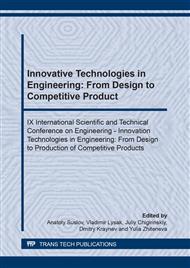[1]
Delan Yin, Shizhong Qiang, Influence of residual stresses and deformation on buckling behaviour of plates, Mechanical effects of welding, International Union of Theoretical and Applied Mechanics. (1992).
DOI: 10.1007/978-3-642-84731-8_27
Google Scholar
[2]
M. Adak, C. Guedes Soares, Effects of different restraints on the weld-induced residual deformations and stresses in a steel plate, The International Journal of Advanced Manufacturing Technology. 71-1 (2014) 699–710.
DOI: 10.1007/s00170-013-5521-9
Google Scholar
[3]
L.R. Botvina, Yu. A. Demina, I.V. Gadolina, I.M. Petrova, M.R. Tyutin, The effect of prolonged aging on fatigue characteristics of steel 45, Industrial Laboratory. 77-1 (2011) 58-61.
Google Scholar
[4]
A.Y. Churyumov, A.V. Mikhailovskaya, M.A. Ryazantseva, A.N. Solonin, Modeling for the structure evolution of alloys of the Al-Cu-Mg system during natural ageing, Russian Journal of Non-Ferrous Metals. 52-1 (2011) 44-49.
DOI: 10.3103/s106782121101024x
Google Scholar
[5]
N. Chawla, J.L. Stewart, J.J. Williams, Influence of thermal aging on the microstructure and mechanical behavior of dual-phase, Precipitation-Hardened, Powder Metallurgy Stainless Steels. Metallurgical and Materials Transactions. 43-1 (2012) 124–135.
DOI: 10.1007/s11661-011-0844-3
Google Scholar
[6]
E.G. Astafurova, V.M. Chernov, M.V. Leontyeva-Smirnova, I.Yu. Litovchenko, E.M. Mozhanov, N.S. Nikolaeva, N.A. Polekhina, A.N. Tyumentsev, Thermal stability of the microstructure of 12% chromium ferritic–martensitic steels after long-term aging at high temperatures, Technical Physics. 61-2 (2016) 209–214.
DOI: 10.1134/s1063784216020092
Google Scholar
[7]
A.A. Chernobaeva, D.Y. Erak, B.A. Gurovich, E.A. Kuleshova, D.A. Maltsev, V.B. Papina, M.A. Skundin, D.A. Zhurko, Chemical composition effect on VVER-1000 RPV weld metal thermal aging, Journal of Nuclear Materials. 465 (2015) 540-549.
DOI: 10.1016/j.jnucmat.2015.06.010
Google Scholar
[8]
O.V. Alekhin, S.I. Bulychev, L.I. Kuksenova, L.M. Rybakova, V.S. Tumasyan, Strain aging in the surface layers of low alloy steel. Metal Science and Heat Treatment. 32-11,12 (1991) 846-851.
DOI: 10.1007/bf00700065
Google Scholar
[9]
A.V. Galtsev, N.V. Kamyshanchenko, I.N. Kuzmenko, I.M. Neklyudov, M.N. Roganin, Effect of strain aging on physical and mechanical properties of austenitic chromium-nickel steel, Metal Science and Heat Treatment. 51-7,8 (2009) 398-403.
DOI: 10.1007/s11041-009-9180-2
Google Scholar
[10]
M. Ghayour, , R.M Homami, M.J. Vardanjani, Analysis of the vibration stress relief for reducing the residual stresses caused by machining, Experimental Techniques.40-2 (2016) 705–713.
DOI: 10.1007/s40799-016-0071-3
Google Scholar
[11]
R. Dawson, D.G. Moffat, Vibratory stress relief: a fundamental study of its effectiveness, Journal of Engineering Materials and Technology. 102-2 (1980) 169–176.
DOI: 10.1115/1.3224793
Google Scholar
[12]
O. Černašejus, M. Lech-Grega, A. Jaskiewicz, A. Jurčius, K.J. Kurzydlowski, A.V. Valiulis, Influence of vibratory stress relief on residual stresses in weldments and mechanical properties of structural steel joint, Journal of Vibroengineering. 12-1 (2010) 133-141.
DOI: 10.3846/bjrbe.2011.31
Google Scholar
[13]
A.F. Balaev, O.Y. Davidenko, A.A. Korolev, A.V. Korolev, E.V. Mukhina, S.A. Savran, A.S. Yakovishin, O.V. Zakharov, Experimental studies of ultrasonic stabilization of rings of rolling bearings. IOP Conf. Series: Materials Science and Engineering 156 (2016) 012007.
DOI: 10.1088/1757-899x/156/1/012007
Google Scholar
[14]
A.F. Balaev, A.A. Korolev, A.V. Korolev, S.A. Savran, A.S. Yakovishin, Experimental study of residual stresses relaxation in ring details during multicyclic loading. IOP Conf. Series: Materials Science and Engineering, 156 (2016) 012011.
DOI: 10.1088/1757-899x/156/1/012011
Google Scholar
[15]
V.V. Bolkunov, A.A. Korolev, A.V. Korolev, A.N. Vasin, Waste-free ultrasonic bearing assembly, Russian Engineering Research. 31-4 (2011) 415–417.
DOI: 10.3103/s1068798x11040125
Google Scholar
[16]
V.V. Bolkunov, A.A. Korolev, A.V. Korolev, S.V. Slesarev, Ultrasonic stabilization of sizes bearing rings with plastic flanges, STIN, 9 (2006) 38–40.
Google Scholar
[17]
A.F. Balaev, A.A. Korolev, A.V. Korolev, A.V. Kochetkov, O.V. Zakharov, Modeling the mechanism of stress relaxation of ring parts at high-cycle loading. Proceedings of 2015 International Conference on Mechanical Engineering, Automation and Control Systems, MEACS. (2015) 1-4.
DOI: 10.1109/meacs.2015.7414977
Google Scholar
[18]
A.M. Chistyakov, A.V. Korolev, V.A. Krivega, G.N. Moiseyev, RU Patent 2140842. (1999).
Google Scholar
[19]
A.F. Balayev, T.A. Baltayev, A.A. Korolev, A.V. Korolev, S.A. Savran, Stabilization technology residual stresses in the elastic sensitive elements of pressure devices through the application of ultrasonic energy. Assembling in Mechanical Engineering and Instrument-Making. 12 (2015) 39-41.
Google Scholar
[20]
T.A. Baltayev, A.V. Korolev, T.M. Mannapova, Mathematical modeling of elastic hysteresis phenomenon in round plates in presence of residual tension, Procedia Engineering. 150 (2016) 81-85.
DOI: 10.1016/j.proeng.2016.06.720
Google Scholar
[21]
A.F. Balaev, T.A. Baltaev, B.M. Iznairov, A.V. Korolev, Experimental study of ultrasonic relaxation of residual stresses in the elastic plates, Vibroengineering PROCEDIA, 8 (2015) 125-129.
Google Scholar


